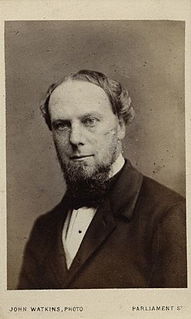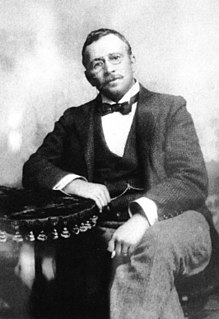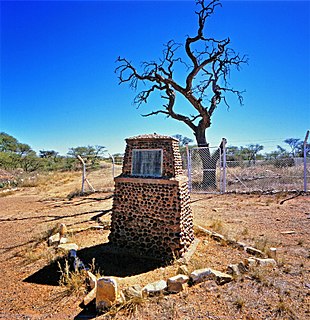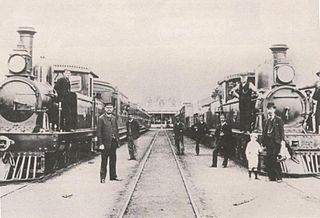
The World's Columbian Exposition was a world's fair held in Chicago in 1893 to celebrate the 400th anniversary of Christopher Columbus' arrival in the New World in 1492. The centerpiece of the Fair, held in Jackson Park, was a large water pool representing the voyage Columbus took to the New World. Chicago had won the right to host the fair over several other cities, including New York City, Washington, D.C., and St. Louis. The exposition was an influential social and cultural event and had a profound effect on architecture, sanitation, the arts, Chicago's self-image, and American industrial optimism.
De Beers Group is an international corporation that specialises in diamond mining, diamond exploitation, diamond retail, diamond trading and industrial diamond manufacturing sectors. The company is active in open-pit, large-scale alluvial, coastal and deep sea mining. It operates in 35 countries and mining takes place in Botswana, Namibia, South Africa, Canada and Australia.

Cecil John Rhodes was a British mining magnate, and politician in southern Africa who served as Prime Minister of the Cape Colony from 1890-96. An ardent believer in British imperialism, Rhodes and his British South Africa Company founded the southern African territory of Rhodesia, which the company named after him in 1895. South Africa's Rhodes University is also named after him. Rhodes set up the provisions of the Rhodes Scholarship, which is funded by his estate. He also put much effort towards his vision of a Cape to Cairo Railway through British territory.

John Wodehouse, 1st Earl of Kimberley, known as The Lord Wodehouse from 1846 to 1866, was a British Liberal politician. He held office in every Liberal administration from 1852 to 1895, notably as Secretary of State for the Colonies and as Foreign Secretary.

Kimberley is the capital and largest city of the Northern Cape Province of South Africa. It is located approximately 110 km east of the confluence of the Vaal and Orange Rivers. The city has considerable historical significance due to its diamond mining past and the siege during the Second Anglo-Boer war. British businessmen Cecil Rhodes and Barney Barnato made their fortunes in Kimberley, and Rhodes established the De Beers diamond company in the early days of the mining town.

Barney Barnato, born Barnet Isaacs, was a British Randlord, one of the entrepreneurs who gained control of diamond mining, and later gold mining, in South Africa from the 1870s. He is perhaps best remembered as being a rival of Cecil Rhodes.

Barkly West is a town in the Northern Cape province of South Africa, situated on the north bank of the Vaal River west of Kimberley.

Sir Julius Charles Wernher, 1st Baronet was a German-born Randlord and art collector who became part of the English establishment.

Makhanda, commonly known as Grahamstown, is a town of about 70,000 people in the Eastern Cape province of South Africa. It is situated about 110 kilometres (70 mi) northeast of Port Elizabeth and 130 kilometres (80 mi) southwest of East London. Makhanda is the largest town in the Makana Local Municipality, and the seat of the municipal council. It also hosts Rhodes University, the Eastern Cape Division of the High Court, the South African Library for the Blind (SALB), a diocese of the Anglican Church of Southern Africa, and 6 South African Infantry Battalion.
Randlords were the entrepreneurs who controlled the diamond and gold mining industries in South Africa in its pioneer phase from the 1870s up to World War I.

The McGregor Museum in Kimberley, South Africa, originally known as the Alexander McGregor Memorial Museum, is a multidisciplinary museum which serves Kimberley and the Northern Cape, established in 1907.
This article describes the history of South African cricket from its known beginnings until the end of the First World War in 1918.

The Siege of Kimberley took place during the Second Boer War at Kimberley, Cape Colony, when Boer forces from the Orange Free State and the Transvaal besieged the diamond mining town. The Boers moved quickly to try to capture the area when war broke out between the British and the two Boer republics in October 1899. The town was ill-prepared, but the defenders organised an energetic and effective improvised defence that was able to prevent it from being taken.

The Sydney International Exhibition was established headed by Lord Augustus Loftus and took place in Sydney in 1879, after being preceded by a number of Metropolitan Intercolonial Exhibitions through the 1870s in Prince Alfred Park.

The Eureka Diamond was the first diamond discovered in South Africa. It originally weighed 21.25 carats (4.250 g), and was later cut to a 10.73-carat (2.146 g) cushion-shaped brilliant, which is currently on display at the Mine Museum in Kimberley. The discovery of diamonds in South Africa led to the Kimberley Diamond Rush, and marked the beginning of the Mineral Revolution.

The Cape Government Railways (CGR) was the government-owned railway operator in the Cape Colony from 1874 until the creation of the South African Railways (SAR) in 1910.

The Glasgow International Exhibition was the second of 4 international exhibitions held in Glasgow, Scotland during the late 19th and early 20th centuries.

The Empire Exhibition, South Africa, held in Johannesburg, was intended to mark that city's jubilee and was opened by the Governor-General of the Union of South Africa on 15 September 1936. It was the first exhibition held in the Union of South Africa following two earlier exhibitions in Cape Colony in 1877 and 1892. The idea of an empire exhibition in South Africa was first discussed in 1934 by the Buy Empire Committee of Johannesburg. On 9 January 1935, the Grand Council of the Federation of British Industries passed a resolution for a proposal to hold an Empire Exhibition in Johannesburg in 1936 in conjunction with the Golden Jubilee of the city.

The South African International Exhibition held in Cape Town, Cape Colony was a world's fair held in 1877 which opened on 15 February by His Excellency Sir Henry Bartle Frere.
















